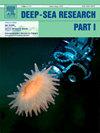2009年Henry B. Bigelow探险队收集的大西洋中脊查理-吉布斯断裂带上的甲壳类动物组合结构
IF 2.1
3区 地球科学
Q2 OCEANOGRAPHY
Deep-Sea Research Part I-Oceanographic Research Papers
Pub Date : 2025-09-24
DOI:10.1016/j.dsr.2025.104596
引用次数: 0
摘要
查理吉布斯断裂带(CGFZ)由两条几乎平行的断裂转换断层组成,它们与大西洋中脊(MAR)轴线相交。由于地形和水,该地区具有较高的初级生产力和生物量水平。南海的一个主要水文特征是亚极锋(SPF),它沿着CGFZ的南部边缘,被称为多种物种的生物地理边界。作为中大西洋北部海洋生物生态系统模式和过程普查项目(MAR-ECO)的一部分,分析了2009年毕格罗航次期间调查的CGFZ甲壳类(主要是十足类)群落的丰度和分布格局。使用配备多采样器的挪威微型浮游动物拖网,从0至3500米深的五个不同深度收集标本。分析表明,相对于CGFZ的地理位置与上层甲壳类的分布有关,但周围的水体可能是甲壳类丰度和多样性变化的主要驱动因素。中上层甲壳类动物的丰度在冻土带西北部的冷水区较高。在温暖的东南海域,由于营养物质和食物供应的稳定流入,以及研究区东南部的中尺度涡流占主导地位,发现了更高的多样性。西北地区底栖甲壳类动物的丰度和多样性均高于东南地区。这表明,在深度上,MAR可能是分隔两个地理区域并降低连通性的生物地理屏障。本文章由计算机程序翻译,如有差异,请以英文原文为准。
Crustacean assemblage structure over the Charlie-Gibbs Fracture Zone of the Mid-Atlantic Ridge collected during the 2009 Henry B. Bigelow expedition
The Charlie Gibbs Fracture Zone (CGFZ) consists of two nearly parallel fracture transform faults that intersect the Mid-Atlantic Ridge (MAR) axis. This area has high primary productivity and biomass levels due to the topography and water. A predominant hydrographic feature of the MAR is the Sub-Polar Front (SPF) which runs along the southern edge of the CGFZ and is known as a biogeographical boundary for multiple species. As part of The Census of Marine Life project Patterns and Processes of the Ecosystem of the northern Mid-Atlantic (MAR-ECO), the abundance and distribution patterns of the CGFZ crustacean community (primarily Decapoda) surveyed during the 2009 H B. Bigelow voyage were analyzed. Specimens were collected from five discrete depths, ranging between 0 and 3500 m deep, using a Norwegian microzooplankton trawl equipped with a multi-sampler. Analyses indicate that geographic location relative to the CGFZ is correlated to pelagic crustacean distribution, but the surrounding water masses are likely the primary drivers of abundance and diversity variations. The abundance of pelagic crustaceans was higher in the cold waters to the northwest of the CGFZ. A higher diversity was found in the warmer southeastern waters presumably due to stable influx of nutrients and food supply, and dominating mesoscale eddies located in the southeast of the study area. Benthic crustaceans in the northwest had an increased abundance and diversity compared the southeast region. This suggests that at depth, the MAR may act as a biogeographic barrier separating the two geographic regions and reducing connectivity.
求助全文
通过发布文献求助,成功后即可免费获取论文全文。
去求助
来源期刊
CiteScore
4.60
自引率
4.20%
发文量
144
审稿时长
18.3 weeks
期刊介绍:
Deep-Sea Research Part I: Oceanographic Research Papers is devoted to the publication of the results of original scientific research, including theoretical work of evident oceanographic applicability; and the solution of instrumental or methodological problems with evidence of successful use. The journal is distinguished by its interdisciplinary nature and its breadth, covering the geological, physical, chemical and biological aspects of the ocean and its boundaries with the sea floor and the atmosphere. In addition to regular "Research Papers" and "Instruments and Methods" papers, briefer communications may be published as "Notes". Supplemental matter, such as extensive data tables or graphs and multimedia content, may be published as electronic appendices.

 求助内容:
求助内容: 应助结果提醒方式:
应助结果提醒方式:


